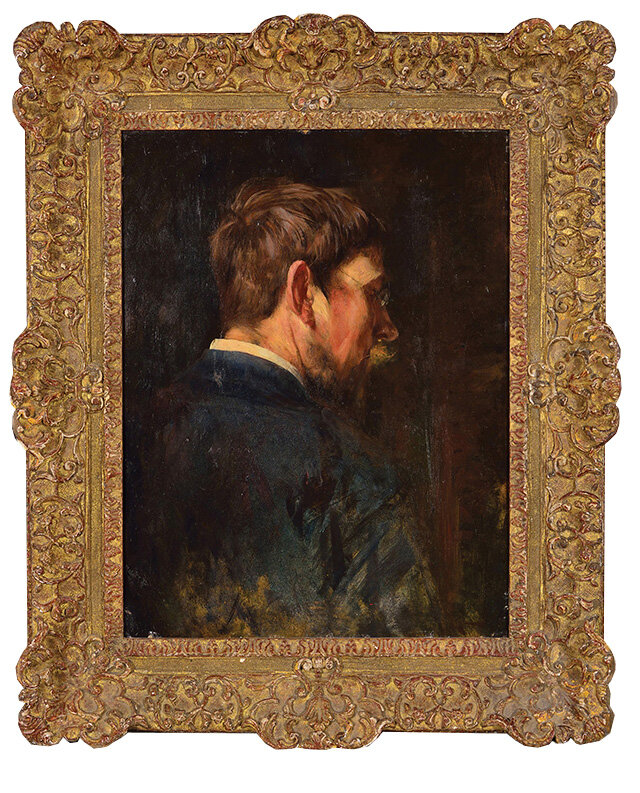Richard L. Hubbard
Richard L. Hubbard
Walking the Horses, 1940
Oil on Canvas
20 x 24 inches
Signed Lower Right
ID: DH2455
This paintings is from the estate of Ken and Judy Klosterman
This following biography was researched, compiled, and written by Geoffrey K. Fleming, Executive Director, Huntington Museum of Art, Huntington, WV.
RICHARD LEDYARD HUBBARD (October 28, 1903 – October 13, 1993)
A.K.A. “Richard L. Hubbard”
Artist, equestrian painter and sculptor of animals. Born in Cazenovia, New York, the son of Helen S. Ledyard (1869 – 1945) and Robert F. Hubbard (1876 – 1949). His father was a farmer in Cazenovia, where Richard Hubbard would spend much of his life.
During the early part of his adulthood Hubbard studied with Cazenovia native, Dwight Williams (1856 – 1932), a well-known landscape painter. Soon after, he began studying at the Pennsylvania Academy of the Fine Arts, where he was a pupil of the sculptor, Charles Grafly (1862 – 1929). In 1923, Hubbard was presented with “a special prize awarded by the president of the Academy, to Richard L. Hubbard, for his modeling from living animals.” That same year he joined other regional artists in exhibiting his work at the Cazenovia Community Art Exhibit, where he showed animals in clay and drawings.
In 1924 Richard Hubbard departed for Europe to study there, with plans to travel for approximately one year through the countries of Great Britain, France, Spain, Italy. He joined other family members for an additional trip to Europe in 1926.
Following his return, he began to focus almost exclusively on the depiction of horses and horse-related activities in his paintings, including racing and hunting. In 1929 he was selected for a solo exhibition by the Chattanooga Art Association, held at the Memorial Auditorium in Chattanooga, Tennessee. The exhibition featured “Thirty colorful and life-like paintings of hunting scenes or race events are included in the group. These are done in tempera and water colors…” Local art reviewers noted:
“A distinct feeling of modernism and a sense of form and proportion are noticeable in the paintings. The larger canvases deal with the complete hunt and include the hunter in vivid riding costume, his grooms, and the hounds, all placed in a suitable background. The smaller paintings depict single incidents of the chase or horse shows. [Hubbard’s] work since he left the Academy has been devoted to the presentation in colors of hunting and race events. His equestrian figures are recognized as of high quality by national and international artists.”
Hubbard remained in Cazenovia during the early 1930s, were he resided on his parent’s farm and where he maintained his own studio and helped organize a retrospective of his instructor’s, Dwight Williams, work in 1932. In 1934 he married fellow artist Elizabeth “Betty” Welsh (1901 – 1967), traveled to Europe and Canada, and not long after was residing with her and his young family in New York City. They first resided on East 62nd Street before moving to East 67th Street in Manhattan.
During the 1950s the Hubbards resided in East Harwich, Massachusetts, from where Hubbard submitted his works to local and regional exhibitions. He was awarded a first prize in 1956 for one of his bronze sculptures at the Boston Festival of Art in Boston, Massachusetts. The Hubbards later returned to New York City where following the death of his first wife in 1967, he married another artist, Prudence Burg (1916 – 2003), and in 1970 settled down in his old hometown of Cazenovia.
From that point forward he participated in many local and regional group exhibitions as well as having a number of solo exhibitions in and around western New York. These included exhibitions held at the Munson Williams Proctor Art Institute in Utica, New York (1971), Log Cabin Art Gallery in Cuyler, New York (1971) and the Associated Artists Gallery in Fayetteville, New York (1976).
Richard Ledyard Hubbard died in Stonehedge Nursing Home located in Chittenango, New York on Wednesday, the 13th of October 1993 at the age of eight-nine years. His service was organized by the Richard F. Ayer Funeral Home and was held from St. Peter's Episcopal Church in Cazenovia. He was buried in Evergreen Cemetery in that city.
While Hubbard participated in a robust number of exhibitions through the early 1930s, the effects of the Great Depression combined with those of the second World War appear to have greatly limited his ability to exhibit again regularly until their conclusions. This makes a great deal of sense, considering his works were associated with the collecting (and social) habits of those with a fairly large annual income. By the 1950s his career had once more taken off, and he found himself a well-represented and exhibited regional artist. That said, he never again received the national success he achieved during the early part of his career, having seen his modernist tendencies replaced by abstraction, pop and other forms of contemporary art.
Though there are undoubtedly other exhibitions in which Hubbard participated, those presently known include the following: Pennsylvania Academy of the Fine Arts, Philadelphia, PA, 1923 (student exhibition, prize), 1933; Cazenovia Community Art Exhibit, Cazenovia, NY, 1923; Chattanooga Art Association, Chattanooga, TN, 1929 (solo); Society of Independent Artists, New York, NY, 1930; Associated Artists, Syracuse Museum of Fine Arts, Syracuse, NY, 1931; National Academy of Design, New York, NY, 1932; Boston Festival of Art, Boston, MA, 1956 (prize); Log Cabin Gallery, Cuyler, NY, 1971; Munson Williams Proctor Art Institute, Utica, NY, 1971; Associated Artists Gallery, Fayetteville, NY, 1976 (with other family members); Merchants National Bank and Trust Company, Cazenovia, NY, 1977 (solo); Montrose Gallery, New York, NY, (u.d., solo).
Hubbard’s works are not known to be in the collections of any public institutions at present, but reside in many private collections throughout the United States.





